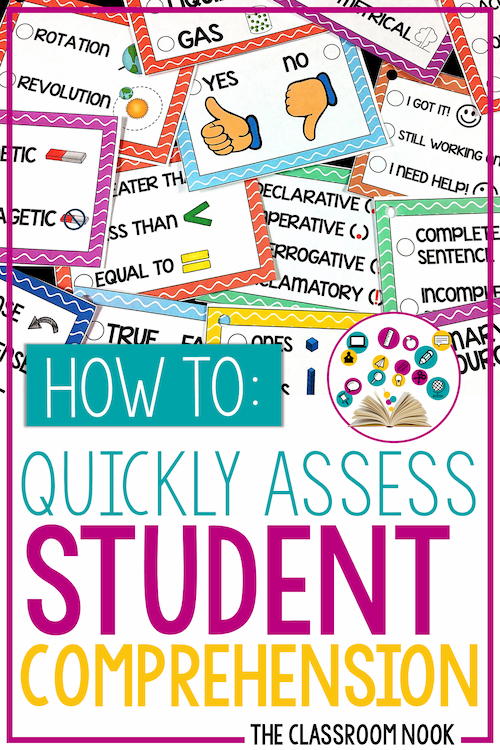How to Quickly Check Your Students' Understanding

As teachers we are always checking for understanding from our students. Whether it's a unit assessment, a reading response, or a written answer, we need to keep track of students who are getting it, and those that aren't.
But - we don't always have time for or even need a formal assessment.
Sometimes we just need to be able to scan the room and take a quick check. Here's a quick tip for doing just that:
How to quickly assess student comprehension:
I created several different cards for different topics where students can quickly show me the answer to a question that I ask related to that topic. I called these my "Show What You Know" cards. On the cards were generic answers to questions that I might ask about different topics to see what my students remembered or understood about what I taught them.
For example, for teaching about primary and secondary sources, I had a card with two answers on it: primary source and secondary source.
When checking my students' understanding of the difference between primary and secondary sources, I could show my students different examples each kind of source and then have them place their finger over the circle next to the correct answer and hold it up for me to see. It was easy for me to scan the room and see who's got it and who doesn't. Students would repeat this process for each question. I could ask follow up questions, as needed.
I also had generic cards that can be used for any topic. Cards with answers like "agree/disagree" and "true/false," or even "yes/no" allowed me to ask questions about the topic we were learning and have students give simple answers. In science, I could ask a question like: Is milk a solid? and students could use the "yes/no" card to respond.
Another type of assessment I liked to use these cards for was assessing my students own assessment of themselves. What do I mean?
Well, I think it's important for students to learn how to assess themselves. I did this by giving students a card with three responses:
Student chose either "I got it!" "Still working on it" or "I need help." Then I could quickly see how students felt about their understanding and I could meet with students who say they still needed help. I could also take it a step further and have students support their response by asking them WHY they think they've got it or WHY they need more help.
USING THE "SHOW WHAT YOU KNOW" CARDS:
To make these cards accessible to all my students in a moment's notice, I made enough sets of the "Show What You Know" cards for each student. Each set was stored on a ring and I placed all my sets in a basket within easy reach. At the end of a lesson when I wanted to get a quick assessment of what we learned, I passed out a set of cards to each student and had them flip to the card that would best assess their understanding of the lesson.
TIP: Number your cards so that you can tell your students what card to go to and they can quickly get to the right one.
Want to give them a try? Grab a FREE SAMPLE SET!
free set of “Show What you Know” Cards
Check your students' comprehension in just a few minutes with one simple assessment tool: show what you know cards!
Students place their finger over the correct answer on the card to indicate their understanding. Teachers can easy scan the room for a quick assessment!
These cards can be used all year long! They are simple to make and it's easy to add a card to the ring as you need new ones.
I also have made up a set that's ready to go with almost 40 "Show What You Know" cards for assessing topics in all content areas including:
comparing numbers (whole numbers and fractions)
main idea/detail
fact/opinion
types of sentences
complete/incomplete sentences
simile/metaphor
syllables
parts of speech
tenses (past, present, future)
living/nonliving things
states of matter
first person/third person
long/short vowel
choosing the correct math operations
base tens blocks
measurement
angles
symmetry
plural/singular words
earth's rotation/revolution
conductor/insulator
magnetic/non-magnetic
plus - editable cards to create your own!
There are also several generic cards like yes/no, agree/disagree, true/false to use for any topic. You can see all the details HERE.





